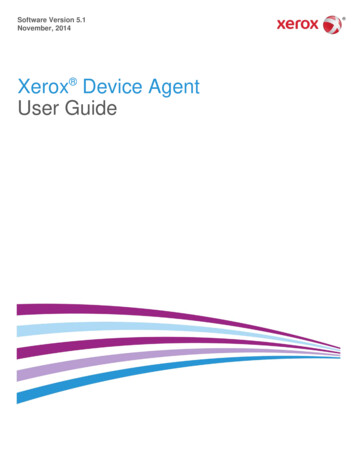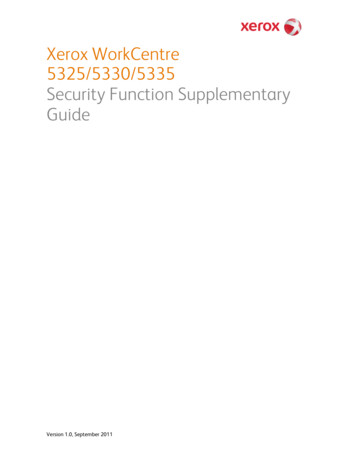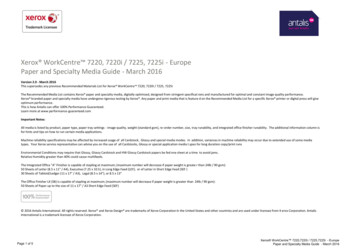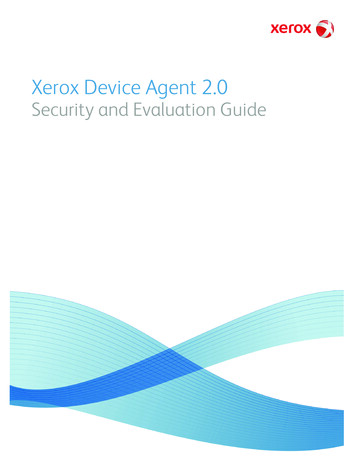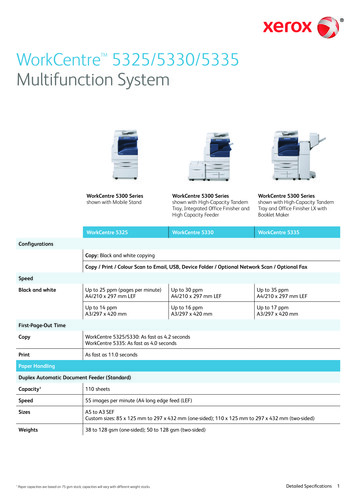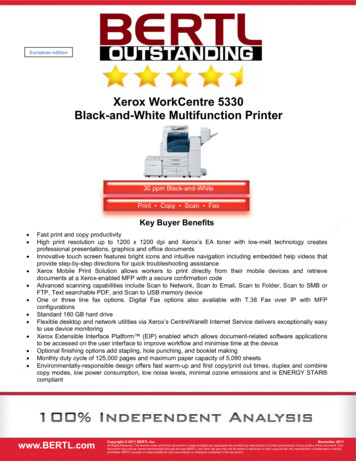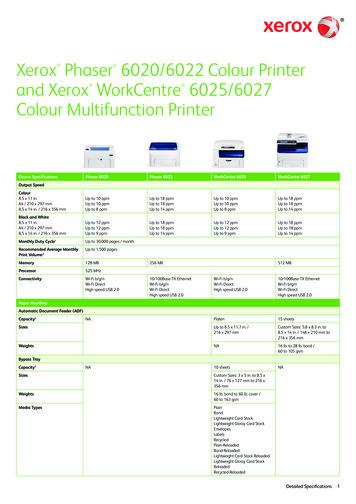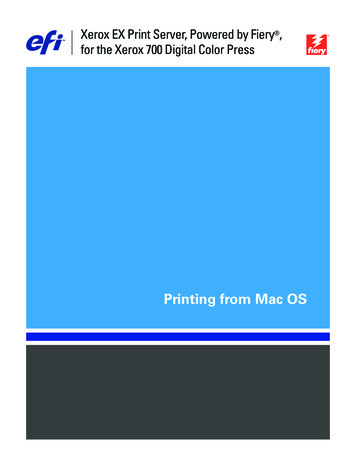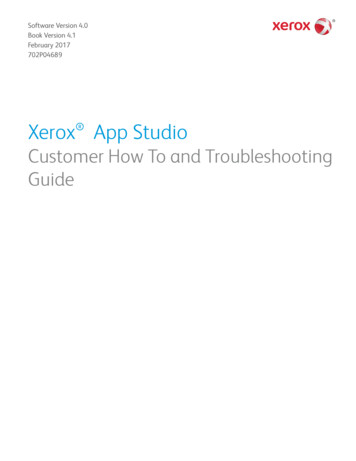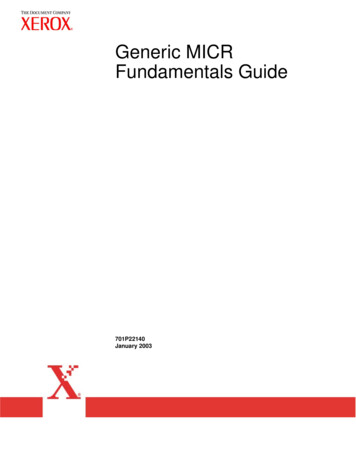
Transcription
Generic MICRFundamentals Guide701P22140January 2003
Xerox Corporation701 S. Aviation BoulevardEl Segundo, CA 90245 2002, 2003 by Xerox Corporation. All rights reserved.Copyright protection claimed includes all forms and matters of copyrightablematerial and information now allowed by statutory or judicial law or hereinaftergranted, including without limitation, material generated from the softwareprograms which are displayed on the screen, such as icons, screen displays,looks, etc.Printed in the United States of America.Publication number: 701P22140Xerox and all Xerox products mentioned in this publication are trademarks ofXerox Corporation. Other products and trademarks of other companies,including Dataglyph , are also acknowledged.Changes are periodically made to this document. Changes, technicalinaccuracies, and typographic errors will be corrected in subsequent editions.
Table of contentsIntroduction . . . . . . . . . . . . . . . . . . . . . . . . . . . . . . . . . . . . . . . . . . . . ixAbout this guide . . . . . . . . . . . . . . . . . . . . . . . . . . . . . . . . . . . . . . . . . . . . . ixHow to use this guide . . . . . . . . . . . . . . . . . . . . . . . . . . . . . . . . . . . . . . . . x1. Overview . . . . . . . . . . . . . . . . . . . . . . . . . . . . . . . . . . . . . . . . . . . . . . 1-1A brief history . . . . . . . . . . . . . . . . . . . . . . . . . . . . . . . . . . . . . . . . . . . . 1-2Why MICR? . . . . . . . . . . . . . . . . . . . . . . . . . . . . . . . . . . . . . . . . 1-5Check printing capabilities . . . . . . . . . . . . . . . . . . . . . . . . . . . . . . . . . . . 1-5Check processing procedure . . . . . . . . . . . . . . . . . . . . . . . . . . . . . . . . . 1-6Production cycle of a check . . . . . . . . . . . . . . . . . . . . . . . . . . . . . . . . . . 1-9Changes in check creation role . . . . . . . . . . . . . . . . . . . . . . . . . . . . . . 1-112. Environment . . . . . . . . . . . . . . . . . . . . . . . . . . . . . . . . . . . . . . . . . . . 2-1Types of MICR applications . . . . . . . . . . . . . . . . . . . . . . . . . . . . . . . . .Manufacturing checks . . . . . . . . . . . . . . . . . . . . . . . . . . . . . . . . .Issuing checks . . . . . . . . . . . . . . . . . . . . . . . . . . . . . . . . . . . . . .Issuing turnaround documents . . . . . . . . . . . . . . . . . . . . . . . . . .Printing financial forms . . . . . . . . . . . . . . . . . . . . . . . . . . . . . . . .Xerox MICR printing systems . . . . . . . . . . . . . . . . . . . . . . . . . . . . . . . .MICR printing technologies . . . . . . . . . . . . . . . . . . . . . . . . . . . . . . . . . .Printer technical optimization . . . . . . . . . . . . . . . . . . . . . . . . . . . . . . . .Typical MICR printing concerns . . . . . . . . . . . . . . . . . . . . . . . . . . . . . .2-12-12-22-22-32-32-42-52-53. Paper facts . . . . . . . . . . . . . . . . . . . . . . . . . . . . . . . . . . . . . . . . . . . . 3-1Paper guidelines . . . . . . . . . . . . . . . . . . . . . . . . . . . . . . . . . . . . . . . . . .MICR paper requirements . . . . . . . . . . . . . . . . . . . . . . . . . . . . . . . . . . .Basis weight . . . . . . . . . . . . . . . . . . . . . . . . . . . . . . . . . . . . . . . .Sheffield smoothness scale . . . . . . . . . . . . . . . . . . . . . . . . . . . .Grain direction . . . . . . . . . . . . . . . . . . . . . . . . . . . . . . . . . . . . . .Moisture content . . . . . . . . . . . . . . . . . . . . . . . . . . . . . . . . . . . . .Reflectance . . . . . . . . . . . . . . . . . . . . . . . . . . . . . . . . . . . . . . . . .Curl . . . . . . . . . . . . . . . . . . . . . . . . . . . . . . . . . . . . . . . . . . . . . . .Perforation . . . . . . . . . . . . . . . . . . . . . . . . . . . . . . . . . . . . . . . . .Metallic content . . . . . . . . . . . . . . . . . . . . . . . . . . . . . . . . . . . . . .Stiffness . . . . . . . . . . . . . . . . . . . . . . . . . . . . . . . . . . . . . . . . . . .Cutting precision . . . . . . . . . . . . . . . . . . . . . . . . . . . . . . . . . . . . .Xerox paper . . . . . . . . . . . . . . . . . . . . . . . . . . . . . . . . . . . . . . . .Generic MICR Fundamentals Guide3-13-23-23-33-43-53-53-63-63-73-73-83-8iii
Table of contentsPaper maintenance . . . . . . . . . . . . . . . . . . . . . . . . . . . . . . . . . . . . . . . . 3-9Wrapping factors . . . . . . . . . . . . . . . . . . . . . . . . . . . . . . . . . . . . 3-9Storage factors . . . . . . . . . . . . . . . . . . . . . . . . . . . . . . . . . . . . . . 3-9Temperature and humidity conditions . . . . . . . . . . . . . . . . . . . 3-10Paper runability criteria . . . . . . . . . . . . . . . . . . . . . . . . . . . . . . . . . . . . 3-11Preprinted forms considerations . . . . . . . . . . . . . . . . . . . . . . . . . . . . . 3-13Inks . . . . . . . . . . . . . . . . . . . . . . . . . . . . . . . . . . . . . . . . . . . . . . 3-13Security features . . . . . . . . . . . . . . . . . . . . . . . . . . . . . . . . . . . . 3-14Duplication detection . . . . . . . . . . . . . . . . . . . . . . . . . . . 3-14Alteration prevention . . . . . . . . . . . . . . . . . . . . . . . . . . . 3-15Application design . . . . . . . . . . . . . . . . . . . . . . . . . . . . . 3-15Numbered stocks . . . . . . . . . . . . . . . . . . . . . . . . . . . . . . 3-15Features to avoid . . . . . . . . . . . . . . . . . . . . . . . . . . . . . . 3-164. Document design . . . . . . . . . . . . . . . . . . . . . . . . . . . . . . . . . . . . . . . 4-1Check document content . . . . . . . . . . . . . . . . . . . . . . . . . . . . . . . . . . . . 4-1Security features . . . . . . . . . . . . . . . . . . . . . . . . . . . . . . . . . . . . . 4-1Background printing . . . . . . . . . . . . . . . . . . . . . . . . . . . . . . . . . . 4-2Fixed information . . . . . . . . . . . . . . . . . . . . . . . . . . . . . . . . . . . . 4-2Date line . . . . . . . . . . . . . . . . . . . . . . . . . . . . . . . . . . . . . . 4-2Amount lines . . . . . . . . . . . . . . . . . . . . . . . . . . . . . . . . . . 4-3Payee line . . . . . . . . . . . . . . . . . . . . . . . . . . . . . . . . . . . . 4-3Signature lines . . . . . . . . . . . . . . . . . . . . . . . . . . . . . . . . . 4-4Name of financial institution . . . . . . . . . . . . . . . . . . . . . . . 4-4Memo line . . . . . . . . . . . . . . . . . . . . . . . . . . . . . . . . . . . . 4-4Account title . . . . . . . . . . . . . . . . . . . . . . . . . . . . . . . . . . . 4-4Check serial number . . . . . . . . . . . . . . . . . . . . . . . . . . . . 4-5Fractional routing number . . . . . . . . . . . . . . . . . . . . . . . . 4-5MICR line . . . . . . . . . . . . . . . . . . . . . . . . . . . . . . . . . . . . . 4-5MICR line (clear band) format requirements . . . . . . . . . . . . . . . . . . . . . 4-5Format specifications using E13B . . . . . . . . . . . . . . . . . . . . . . . . . . . . . 4-7E13B character set . . . . . . . . . . . . . . . . . . . . . . . . . . . . . . . . . . . 4-7E13B numbers . . . . . . . . . . . . . . . . . . . . . . . . . . . . . . . . . 4-7E13B symbols . . . . . . . . . . . . . . . . . . . . . . . . . . . . . . . . . 4-7On-Us symbol . . . . . . . . . . . . . . . . . . . . . . . . . . . . 4-7Transit symbol . . . . . . . . . . . . . . . . . . . . . . . . . . . . 4-8Amount symbol . . . . . . . . . . . . . . . . . . . . . . . . . . . 4-8Dash symbol . . . . . . . . . . . . . . . . . . . . . . . . . . . . . 4-8E13B character design . . . . . . . . . . . . . . . . . . . . . . . . . . 4-9Field formats—E13B font . . . . . . . . . . . . . . . . . . . . . . . . . . . . . . 4-9Document Specifications form . . . . . . . . . . . . . . . . . . . . 4-11Amount field . . . . . . . . . . . . . . . . . . . . . . . . . . . . . . . . . . 4-13On-Us field . . . . . . . . . . . . . . . . . . . . . . . . . . . . . . . . . . . 4-13Transit field . . . . . . . . . . . . . . . . . . . . . . . . . . . . . . . . . . 4-13External processing code (EPC) field . . . . . . . . . . . . . . 4-14Auxiliary On-Us field . . . . . . . . . . . . . . . . . . . . . . . . . . . 4-14ivGeneric MICR Fundamentals Guide
Table of contentsField formats summary . . . . . . . . . . . . . . . . . . . . . . . . .Character alignment . . . . . . . . . . . . . . . . . . . . . . . . . . . . . . . . .CMC7 font . . . . . . . . . . . . . . . . . . . . . . . . . . . . . . . . . . . . . . . . . . . . . .CMC7 numbers and symbols . . . . . . . . . . . . . . . . . . . . . . . . . .Character design . . . . . . . . . . . . . . . . . . . . . . . . . . . . . . . . . . .MICR character spacing requirements . . . . . . . . . . . . . . . . . . . . . . . .Character spacing algorithm for 300 dpi . . . . . . . . . . . . . . . . . .Fixed pitch and proportional font spacing . . . . . . . . . . . . . . . . .Check size . . . . . . . . . . . . . . . . . . . . . . . . . . . . . . . . . . . . . . . . . . . . . .Other application considerations . . . . . . . . . . . . . . . . . . . . . . . . . . . . .Two sided printing . . . . . . . . . . . . . . . . . . . . . . . . . . . . . . . . . .Perforations . . . . . . . . . . . . . . . . . . . . . . . . . . . . . . . . . . . . . . .Multiple-up printing . . . . . . . . . . . . . . . . . . . . . . . . . . . . . . . . . .Readability . . . . . . . . . . . . . . . . . . . . . . . . . . . . . . . . . . . . . . . . . . . . . -254-275. Document processing . . . . . . . . . . . . . . . . . . . . . . . . . . . . . . . . . . . 5-1Proofing checks . . . . . . . . . . . . . . . . . . . . . . . . . . . . . . . . . . . . . . . . . . . 5-2Amount determination errors . . . . . . . . . . . . . . . . . . . . . . . . . . . 5-2Proofing equipment errors . . . . . . . . . . . . . . . . . . . . . . . . . . . . . 5-2Reader sorter function . . . . . . . . . . . . . . . . . . . . . . . . . . . . . . . . . . . . . . 5-3Waveform generation . . . . . . . . . . . . . . . . . . . . . . . . . . . . . . . . . 5-4Types of reader sorters . . . . . . . . . . . . . . . . . . . . . . . . . . . . . . . . . . . . . 5-5Waveform reader sorters . . . . . . . . . . . . . . . . . . . . . . . . . . . . . . 5-5Matrix or AC reader sorters . . . . . . . . . . . . . . . . . . . . . . . . . . . . 5-5Optical reader sorters . . . . . . . . . . . . . . . . . . . . . . . . . . . . . . . . . 5-6Dual read magnetic reader sorters . . . . . . . . . . . . . . . . . . . . . . . 5-6Hybrid magnetic and optical reader sorters . . . . . . . . . . . . . . . . 5-7Processing speeds . . . . . . . . . . . . . . . . . . . . . . . . . . . . . . . . . . . . . . . . 5-7Paper handling by reader sorters . . . . . . . . . . . . . . . . . . . . . . . . . . . . . 5-8Hopper jogger . . . . . . . . . . . . . . . . . . . . . . . . . . . . . . . . . . . . . . . 5-8Separator . . . . . . . . . . . . . . . . . . . . . . . . . . . . . . . . . . . . . . . . . . 5-8Aligner . . . . . . . . . . . . . . . . . . . . . . . . . . . . . . . . . . . . . . . . . . . . 5-9Read/write heads . . . . . . . . . . . . . . . . . . . . . . . . . . . . . . . . . . . . 5-9Item numbering and endorsing stations . . . . . . . . . . . . . . . . . . . 5-9Microfilm or image capture unit . . . . . . . . . . . . . . . . . . . . . . . . . 5-9Sorter pockets . . . . . . . . . . . . . . . . . . . . . . . . . . . . . . . . . . . . . 5-10Reject repair . . . . . . . . . . . . . . . . . . . . . . . . . . . . . . . . . . . . . . . . . . . . 5-106. Quality control . . . . . . . . . . . . . . . . . . . . . . . . . . . . . . . . . . . . . . . . . 6-1Print quality specifications . . . . . . . . . . . . . . . . . . . . . . . . . . . . . . . . . . .Optical tools used to check MICR . . . . . . . . . . . . . . . . . . . . . . . . . . . . .MICR Gauge . . . . . . . . . . . . . . . . . . . . . . . . . . . . . . . . . . . . . . . .Small Optical Comparator . . . . . . . . . . . . . . . . . . . . . . . . . . . . .Magnetic testing equipment . . . . . . . . . . . . . . . . . . . . . . . . . . . . . . . . .E13B calibration document . . . . . . . . . . . . . . . . . . . . . . . . . . . . . . . . . .Testing sample documents . . . . . . . . . . . . . . . . . . . . . . . . . . . . . . . . . .Generic MICR Fundamentals Guide6-16-26-26-36-36-46-5v
Table of contentsSpecifications for testing . . . . . . . . . . . . . . . . . . . . . . . . . . . . . . . . . . . . 6-6Horizontal position . . . . . . . . . . . . . . . . . . . . . . . . . . . . . . . . . . . 6-6Vertical position . . . . . . . . . . . . . . . . . . . . . . . . . . . . . . . . . . . . . 6-7Skew . . . . . . . . . . . . . . . . . . . . . . . . . . . . . . . . . . . . . . . . . . . . . . 6-9Character-to-character spacing . . . . . . . . . . . . . . . . . . . . . . . . 6-11Voids . . . . . . . . . . . . . . . . . . . . . . . . . . . . . . . . . . . . . . . . . . . . . 6-13Extraneous ink spots . . . . . . . . . . . . . . . . . . . . . . . . . . . . . . . . 6-14Signal strength . . . . . . . . . . . . . . . . . . . . . . . . . . . . . . . . . . . . . 6-17Debossment and embossment . . . . . . . . . . . . . . . . . . . . . . . . . 6-20Summary of ANSI standards . . . . . . . . . . . . . . . . . . . . . . . . . . 6-21Additional performance considerations . . . . . . . . . . . . . . . . . . 6-22Dry ink slivers . . . . . . . . . . . . . . . . . . . . . . . . . . . . . . . . 6-22Damaged or ragged characters . . . . . . . . . . . . . . . . . . . 6-22Crayoning . . . . . . . . . . . . . . . . . . . . . . . . . . . . . . . . . . . 6-22Operational maintenance . . . . . . . . . . . . . . . . . . . . . . . . . . . . . . . . . . 6-22Quality measurements: magnetic versus optical . . . . . . . . . . . . . . . . . 6-23Magnetic testing equipment usage . . . . . . . . . . . . . . . . . . . . . . 6-23Optical testing equipment usage . . . . . . . . . . . . . . . . . . . . . . . 6-25Recommendation . . . . . . . . . . . . . . . . . . . . . . . . . . . . . . . . . . . 6-267. Problem solving . . . . . . . . . . . . . . . . . . . . . . . . . . . . . . . . . . . . . . . . 7-1When problem solving is required . . . . . . . . . . . . . . . . . . . . . . . . . . . . . 7-1New accounts . . . . . . . . . . . . . . . . . . . . . . . . . . . . . . . . . . . . . . . 7-1Existing applications . . . . . . . . . . . . . . . . . . . . . . . . . . . . . . . . . . 7-1Possible misinterpretations . . . . . . . . . . . . . . . . . . . . . . . . . . . . . 7-2Problem solving process . . . . . . . . . . . . . . . . . . . . . . . . . . . . . . . . . . . . 7-2Determining the problem source . . . . . . . . . . . . . . . . . . . . . . . . 7-4Reader sorter . . . . . . . . . . . . . . . . . . . . . . . . . . . . . . . . . . 7-4Printer . . . . . . . . . . . . . . . . . . . . . . . . . . . . . . . . . . . . . . . 7-4Operator training . . . . . . . . . . . . . . . . . . . . . . . . . . . . . . . 7-4Application software . . . . . . . . . . . . . . . . . . . . . . . . . . . . . 7-5Unknown cause . . . . . . . . . . . . . . . . . . . . . . . . . . . . . . . . 7-5Reader sorter testing . . . . . . . . . . . . . . . . . . . . . . . . . . . . . . . . . 7-5Interpreting test results . . . . . . . . . . . . . . . . . . . . . . . . . . 7-6Questions to consider . . . . . . . . . . . . . . . . . . . . . . . . . . . 7-7Expected reject rates . . . . . . . . . . . . . . . . . . . . . . . . . . . . . . . . . 7-9Reducing reject rates . . . . . . . . . . . . . . . . . . . . . . . . . . . . 7-9Inspecting documents . . . . . . . . . . . . . . . . . . . . . . . . . . . . . . . . 7-12Correct font placement or format . . . . . . . . . . . . . . . . . . 7-12MICR character defects . . . . . . . . . . . . . . . . . . . . . . . . . 7-12Document damage . . . . . . . . . . . . . . . . . . . . . . . . . . . . 7-13Excessive ink smears . . . . . . . . . . . . . . . . . . . . . . . . . . 7-13Paper size and characteristics . . . . . . . . . . . . . . . . . . . . 7-13MICR line format . . . . . . . . . . . . . . . . . . . . . . . . . . . . . . 7-13Job history or results . . . . . . . . . . . . . . . . . . . . . . . . . . . 7-14Compare the documents with previous samples . . . . . . 7-14viGeneric MICR Fundamentals Guide
Table of contentsAnalyzing reader sorter printout . . . . . . . . . . . . . . . . . . . . . . . . 7-14Test patterns: alternative to reader sorter testing . . . . . . . . . . . 7-15Verifying problem resolution . . . . . . . . . . . . . . . . . . . . . . . . . . . . . . . . 7-168. Security . . . . . . . . . . . . . . . . . . . . . . . . . . . . . . . . . . . . . . . . . . . . . . . 8-1Xerox printing systems security . . . . . . . . . . . . . . . . . . . . . . . . . . . . . . . 8-1Physical security . . . . . . . . . . . . . . . . . . . . . . . . . . . . . . . . . . . . . 8-2Restricting physical access . . . . . . . . . . . . . . . . . . . . . . . 8-2Securing paper stocks . . . . . . . . . . . . . . . . . . . . . . . . . . . 8-3Storage and disposal . . . . . . . . . . . . . . . . . . . . . . . . . . . . 8-3Responsible presence . . . . . . . . . . . . . . . . . . . . . . . . . . . 8-4Software security . . . . . . . . . . . . . . . . . . . . . . . . . . . . . . . . . . . . 8-4Logon levels . . . . . . . . . . . . . . . . . . . . . . . . . . . . . . . . . . . 8-4Memory . . . . . . . . . . . . . . . . . . . . . . . . . . . . . . . . . . . . . . 8-4System commands . . . . . . . . . . . . . . . . . . . . . . . . . . . . . 8-5Audit control processes . . . . . . . . . . . . . . . . . . . . . . . . . . . . . . . 8-5Accounting information . . . . . . . . . . . . . . . . . . . . . . . . . . 8-5Paper jams . . . . . . . . . . . . . . . . . . . . . . . . . . . . . . . . . . . . 8-5Samples . . . . . . . . . . . . . . . . . . . . . . . . . . . . . . . . . . . . . . 8-6Tampering methods . . . . . . . . . . . . . . . . . . . . . . . . . . . . . . . . . . . . . . . 8-7Chemical tampering . . . . . . . . . . . . . . . . . . . . . . . . . . . . . . . . . . 8-7Mechanical tampering . . . . . . . . . . . . . . . . . . . . . . . . . . . . . . . . 8-7Modifying printed checks . . . . . . . . . . . . . . . . . . . . . . . . . . . . . . 8-8Lithographic printing . . . . . . . . . . . . . . . . . . . . . . . . . . . . 8-8Impact printing . . . . . . . . . . . . . . . . . . . . . . . . . . . . . . . . . 8-8Cold pressure fix . . . . . . . . . . . . . . . . . . . . . . . . . . . . . . . 8-9Xerography . . . . . . . . . . . . . . . . . . . . . . . . . . . . . . . . . . . 8-9Preventing tampering . . . . . . . . . . . . . . . . . . . . . . . . . . . . . . . . 8-10Safety papers . . . . . . . . . . . . . . . . . . . . . . . . . . . . . . . . . . . . . . 8-11Overprints . . . . . . . . . . . . . . . . . . . . . . . . . . . . . . . . . . . . . . . . . 8-11Textures . . . . . . . . . . . . . . . . . . . . . . . . . . . . . . . . . . . . . . . . . . 8-11Amount limit statements . . . . . . . . . . . . . . . . . . . . . . . . . . . . . . 8-12Amount in Words fields . . . . . . . . . . . . . . . . . . . . . . . . . . . . . . . 8-12Preventing check duplication . . . . . . . . . . . . . . . . . . . . . . . . . . . . . . . . 8-12Microprint . . . . . . . . . . . . . . . . . . . . . . . . . . . . . . . . . . . . . . . . . 8-13Watermarks . . . . . . . . . . . . . . . . . . . . . . . . . . . . . . . . . . . . . . . 8-13Drop-out print . . . . . . . . . . . . . . . . . . . . . . . . . . . . . . . . . . . . . . 8-13Dataglyph . . . . . . . . . . . . . . . . . . . . . . . . . . . . . . . . . . . . . . . 8-14VOID pantograph . . . . . . . . . . . . . . . . . . . . . . . . . . . . . . . . . . . 8-14Avoiding counterfeit and stolen checks . . . . . . . . . . . . . . . . . . . . . . . . 8-14Alteration . . . . . . . . . . . . . . . . . . . . . . . . . . . . . . . . . . . . . . . . . 8-14Embezzlement . . . . . . . . . . . . . . . . . . . . . . . . . . . . . . . . . . . . . 8-15Stolen checks . . . . . . . . . . . . . . . . . . . . . . . . . . . . . . . . . . . . . . 8-16Counterfeits . . . . . . . . . . . . . . . . . . . . . . . . . . . . . . . . . . . . . . . 8-16Cost considerations . . . . . . . . . . . . . . . . . . . . . . . . . . . . . . . . . . . . . . . 8-17Generic MICR Fundamentals Guidevii
Table of contentsA. References . . . . . . . . . . . . . . . . . . . . . . . . . . . . . . . . . . . . . . . . . . . .A-1Standards documentation . . . . . . . . . . . . . . . . . . . . . . . . . . . . . . . . . . .Instructions for ordering U. S. standards . . . . . . . . . . . . . . . . . . . . . . . .Ordering online . . . . . . . . . . . . . . . . . . . . . . . . . . . . . . . . . . . . . .Ordering hardcopy . . . . . . . . . . . . . . . . . . . . . . . . . . . . . . . . . . .Standards development process information (U. S. only) . . . . .A-1A-2A-2A-2A-3Glossary . . . . . . . . . . . . . . . . . . . . . . . . . . . . . . . . . . . . . . . Glossary-1Index . . . . . . . . . . . . . . . . . . . . . . . . . . . . . . . . . . . . . . . . . . . . . Index-1viiiGeneric MICR Fundamentals Guide
IntroductionAbout this guideThe purpose of the Generic MICR Fundamentals Guide is toprovide a reference for the various facets of the MICRenvironment within the context of the Xerox MICR printingproducts. This document does not contain specific informationon individual Xerox MICR printers.Since the printing of MICR documents involves application andoperational considerations not normally associated with any ofthe standard Xerox printing systems, this document providesprinciples and guidelines to ensure successful MICR printing.This document has been developed with the assumption thatreaders have knowledge of standard Xerox printing systemsproducts, and the skills to develop applications and job sourcelibraries.The Generic MICR Fundamentals Guide contains the followingchapters and appendices:Chapter 1: Overview. Describes MICR, its historicalbackground, and the printing and processing procedures for theMICR document.Chapter 2: Environment. Examines the types of applicationsthat use MICR, trends within the industry, and typical MICRprinting methods and concerns.Chapter 3: Paper facts. Identifies paper grades and propertiesrequired for MICR printing, and describes paper maintenanceprocedures.Chapter 4: Document design. Describes the standard format,features, and requirements of a check document.Chapter 5: Document processing. Examines the commontypes of reader sorter technology and the way these systemsfunction.Generic MICR Fundamentals Guideix
IntroductionChapter 6: Quality control. Describes MICR document printquality specifications, the tools available to determine if adocument is within specifications, and general operatormaintenance procedures.Chapter 7: Problem solving. Provides information onidentifying MICR printer related problems and using rejectionrate information to isolate the problem source.Chapter 8: Security. Provides an overview of the securityprocedures used to control and audit access to a Xerox MICRprinting system and to check printing functions.Appendix A: MICR references. Lists the domestic andinternational standards documents that apply to MICRpublications. Also contains a list of Xerox documents containingMICR information.Glossary: Lists terms and definitions related to MICR printingand banking environments.How to use this guidex First, become thoroughly familiar with the operation of yourown MICR system. Read through this guide to acquaint yourself with all of thetopics. As needed, refer to sections of this guide that are pertinent toyour work.Generic MICR Fundamentals Guide
1.OverviewMICR (Magnetic Ink Character Recognition) is a process bywhich documents are printed using magnetic ink and specialfonts to create machine readable information for quick documentprocessing.Although traditionally MICR has been used to print accountingand routing information on bank checks and other negotiabledocuments, the magnetic encoding lends itself to any form ofdocument processing.The following figure shows a check with a MICR line. This linecontains block-shaped numbers running along the bottom of thecheck, and non-numeric characters called “symbols.” This entirestring of numbers and symbols is printed using magnetic ink.Figure 1-1. MICR line on a checkGeneric MICR Fundamentals Guide1-1
OverviewA brief historyOriginally, checks were processed manually. However, by themid-1940s the banking system became inundated with paper associety grew more mobile and affluent. Finding a means ofhandling the growing number of paper documents became vitalto bankers. The banking and electronics industries searched fora standard process that could be used in all banks throughoutthe country.In the mid-1950s, the first automated processing of checks wasinitiated. The system that is now known as MICR was developedby the Stanford Research Institute, using equipment designed bythe General Electric Computer Laboratory. The E13B MICR fontwas also developed.The specifications for producing the E13B font using magneticink were accepted as a standard by the American BankersAssociation (ABA) in 1958. In April 1959, the ABA issuedPublication 147, The Common Machine Language forMechanized Check Handling.Deluxe Check Printers had the task of translating thespecifications into a working process. By the end of 1959,Deluxe successfully produced checks using magnetic ink.In countries throughout the world there are groups that setstandards and dictate the design specifications for documentencoding, processing equipment, and quality criteria for MICRprinting. Some of these are:1-2 American Banking Association (ABA) American National Standards Institute (ANSI) United Kingdom—Association for Payment Clearing Services(APACS) Canadian Payments Association (CPA) Australian Bankers Association (ABA) International Organization for Standardization (ISO) France—L'Association Francaise de NormalisationGeneric MICR Fundamentals Guide
OverviewIn 1963, the American National Standards Institute (ANSI)accepted the ABA specifications, with minor revisions, as theAmerican standard for MICR printing. The ANSI publicationcovering these standards is Print Specifications for Magnetic InkCharacter Recognition, first issued in 1969. Although compliancewith the standards is voluntary in the U. S., the banking industryconsiders them to be the definitive basis for determiningacceptable quality of a MICR document.Another MICR font, called CMC7, was developed by the Frenchcomputer company Machines Bull and has been the officialFrench standard since September 1964. The CMC7 font is alsoused in other countries, including Italy, Spain, and Brazil. Like theE13B font, CMC7 is a magnetically readable font, but with adifferent character design and recognition criteria.Some countries also use OCR-A or OCR-B, which are opticallyread check processing fonts. These fonts do not need to beprinted with magnetic ink in order to be processed. The followingtable shows which countries use the four check printing fonts.Generic MICR Fundamentals Guide1-3
OverviewCountryE13B CMC7 OCR-A OCR-BNorth America:USAXCanadaXCentral AmericaBermudaXMexicoXPanamaXSouth XXSpainXSwedenXXUnited KingdomXXMiddle East and Africa:IsraelXSouth AfricaXFar East:AustraliaXHong KongXIndiaXJapanXXKuala LumurXMalaysiaXNew eneric MICR Fundamentals Guide
OverviewRecognizing significant market value in combining theadvantages of electronic laser xerography with MICR technology,Xerox initiated investigations in late 1979 and early 1980. Earlyefforts at the Xerox Webster Research Center concentrated onbasic material physics. The objective was to provide axerographic dry ink and developer that would produce high visualquality images that could be read using the standard bankingreader sorter equipment.Xerox’s MICR printing products combine the following: A modified xerographic engine A unique magnetic materials package The standard ANSI and ISO MICR character setsThe Xerox MICR systems meet ANSI, CPA, and ISOspecifications for automatic check handling.Why MICR?MICR was chosen by the ABA because it can be read accuratelyby machine, it uses existing printing technology, and the printeddocuments are durable to withstand mutilation.A MICR encoded document can be read through overstamping,pen and pencil marks, oils and greases, and carbon smudges.However, MICR printing is one of the most quality-consciousapplication areas within the printing industry. It meets ABAsecurity requirements for negotiable documents. MICR is theonly system that produces reliable results at high processingspeed.Check printing capabilitiesA Xerox MICR printing system with a magnetic material packageand MICR fonts can print a character line at the bottom of acheck form that is machine readable by standard banking readersorter equipment. On blank security paper, the Xerox MICRprinting system can produce the entire check image, includingthe form, all fixed and variable data, logos and signatures, andthe MICR line, in a single pass.Generic MICR Fundamentals Guide1-5
OverviewThe printing process is one small part of the total processingprocedure for a MICR printing system user. Quality and accuracyof the check documents must be closely controlled duringprinting to prevent problems from occurring when the documentis processed off-site.Check processing procedureAll checks impact at least three parties: The person who writes the check The person to whom the check is being paid The bank at which the check writer has an accountDepending on where and by whom the check is deposited, howthe check is processed, and how the check is handled for fundsclearance, many different parties can handle the same check.Fraud can occur at any of the steps or access points in thisprocess.The following steps, illustrated in figure 1-2, trace a documentthrough a series of corporate and ba
Chapter 7: Problem solving. Provides information on identifying MICR printer related problems and using rejection rate information to isolate the problem source. Chapter 8: Security. Provides an overview of the security procedures used to control and audit access to a Xe
